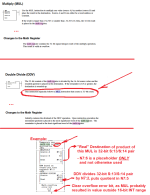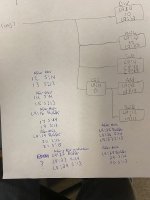Hello All
I am trying to convert a ML1000 program for use in a ML1400. I didn't create the original program & documentation is non existent. When I changed processor to a ML1400 in the program I had alot of DDV errors & High Speed Counter errors. I haven't looked at the HSC errors yet but am trying to get rid of the DDV problems. For some of them I think I can just change the destination of the MUL instruction to a long integer & just do a regular DIV but I'm not sure what to do with the logic in the attached file. I think N7:30 & N7:31 are setpoints in the HMI but I really have no way to verify it. Can I do a regular divide on the 32bit math register to get the same results as the DDV? In the DIV instruction if you reference S:13 does it still do a 32bit division of the combined words S:13 & S:14. Sorry for the rambling here but I have been beating my head on my desk trying to get a handle on this. Any help would be greatly appreciated! By the way this program is on a pipe cutting machine on a pipe mill which cuts the pipe at the appropriate length as the pipe is moving out of the mill.
I am trying to convert a ML1000 program for use in a ML1400. I didn't create the original program & documentation is non existent. When I changed processor to a ML1400 in the program I had alot of DDV errors & High Speed Counter errors. I haven't looked at the HSC errors yet but am trying to get rid of the DDV problems. For some of them I think I can just change the destination of the MUL instruction to a long integer & just do a regular DIV but I'm not sure what to do with the logic in the attached file. I think N7:30 & N7:31 are setpoints in the HMI but I really have no way to verify it. Can I do a regular divide on the 32bit math register to get the same results as the DDV? In the DIV instruction if you reference S:13 does it still do a 32bit division of the combined words S:13 & S:14. Sorry for the rambling here but I have been beating my head on my desk trying to get a handle on this. Any help would be greatly appreciated! By the way this program is on a pipe cutting machine on a pipe mill which cuts the pipe at the appropriate length as the pipe is moving out of the mill.




